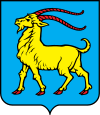Žminj
Žminj (Italian: Gimino) is a small town in Istria, Croatia, 15 km south of Pazin. It has a population of 3,483, and was first mentioned in 1177 as a parish of the Poreč diocese.
Žminj | |
|---|---|
Municipality | |
| Žminj Municipality | |
 Žminj Location of Žminj in Croatia | |
| Coordinates: 45°09′N 13°55′E | |
| Country | Croatia |
| County | Istria |
| Elevation | 355 m (1,165 ft) |
| Population (2011)[1] | |
| • Total | 3,483 |
| Time zone | UTC+1 (CET) |
| • Summer (DST) | UTC+2 (CEST) |
| Website | www |
The town is located on a limestone hill between the Lim valley and the Raša valley, 355 meters above sea level. Its economy is based on farming and livestock breeding. Žminj is located at the intersection of regional roads to Pazin, Kanfanar, Svetvinčenat and Labin. This unique part of Istria has a number of attractions - beautiful landscapes and remnants of cultural heritage from all ages (such as a tower Citadel in the old town).
Exquisite specialities of Istrian cuisine: "maneštra" (minestra), sausages with cabbage, venison with "fuži" (a kind of pasta), "supa" (crisp bread in red wine, with olive-oil and pepper) and the famous wines, teran and malmsey.
Žminj and its surroundings are used hiking and cycling tours, as well as for agritourism, which developed in many of the surrounding villages. Žminj is the traditional host of one of the most popular folk festivities in Istria, the Bartulja (at the end of August), dedicated to St. Bartholomew, patron of Žminj (in the church of St. Bartholomew).
Other traditional events are the Chakavian Assembly, a contest of young poets and reciters of poetry in the Chakavian dialect (in June) and the Harmonica Wedding, a competition in accordion-playing (in July).
Žminj is also known for its agricultural fair which takes place every second Wednesday in the month.
Notable people
- Gabrijela Galant Jelenić, musician, grew up in Žminj.[2]
References
- "Population by Age and Sex, by Settlements, 2011 Census: County of Istria". Census of Population, Households and Dwellings 2011. Zagreb: Croatian Bureau of Statistics. December 2012.
- Džepina, Darko (11 May 2010). "Prvih nekoliko sati smo bili par, a zatim je nastala Nola!". Dnevnik (in Croatian). Retrieved 26 February 2019.
